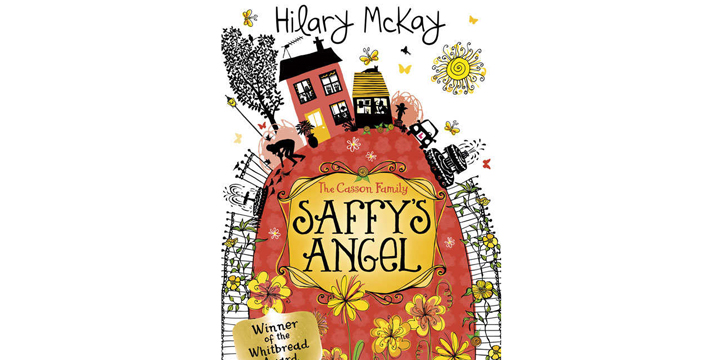Saffy’s Angel defies plot. This is the genius of the book. Oh, there is a sequence of events, to be sure. There is a beginning, middle, and end, but these are not what keeps a person reading Saffy’s Angel. The success of the book rests upon the personalities within it. I say ‘personalities’ because there are many who will charm and intrigue you; however, all these personalities add up to one magnificent personality—that of the Casson Family.
The first time I read Saffy’s Angel and met the Casson family I was left with the feeling of standing outside a window in the rain and cold watching a family playing games inside next to a warm fire while snacking on popcorn and root beer. It wasn’t the warm fire or food I yearned for—it was to be a part of the Casson family.
While every family is unique, the Casson family is magically so. Start with the names of the children: Cadmium Gold, Saffron, Indigo Blue, and Permanent Rose. Those on the names on their birth certificates, but to each other and their friends they are known as Caddy, Saffy, Indigo, and Rose. You’ve noticed that their names are colors? That’s because all but Saffy’s names were taken from a painter’s color chart that hangs on their kitchen wall. Why Saffron’s color isn’t there is a mystery that lasts as long as the first chapter.
“Why isn’t there a Saffron?” demanded Saffron. “There’s all the others. What about me?”
Then the health visitor said the thing that changed Saffron’s life. She looked up from unpicking something out of Rose’s clenched fist and said to the children’s mother:
“Doesn’t Saffron know?”
The words fell into a moment of silence. Rose held her breath between roars. Caddy’s head jerked up and her eyes were startled. Indigo stopped hammering. Eve went scarlet and looked very confused and began an unhappy mumble. A not-yet, not-now sort of mumble.
“Know what?” asked Saffron, looking from the health visitor to her mother.
But the book is not a mystery. Nothing hinges on what is known or unknown. Each time you pick up the book it is because you want to be with the Cassons. There is Eve, the Casson mother, who is a very bad mother (“Oh, darling. Darling.”) and yet a mother every child should have in his life. Caddy, is the oldest, and a lovely girl and human being. She raises guinea pigs:
“Caddy . . . was absorbed in painting the soles of her hamster’s feet” and “let the hamster walk across the table and it made a delicate and beautiful pattern of rainbow-coloured footprints all over the health visitor’s notes.”
And Caddy is in love with her driving instructor:
“Oh, Michael darling!”
“Don’t call me darling, I’m a driving instructor.”
Saffy is fierce, angry, and a loyal friend if you can win her over. In this story, winning Saffy over means running her over:
“Do you know where Saffy is, Rose?”
“Run off,” she said, poking a large paint brush into the Marmite. “After Dad. Chucking sandwiches. Screaming. Got squashed flat by that girl in the wheelchair.”
Indigo is intensely protective of his family (his “brood”). He wants to be an explorer, but first must overcome so many fears. He will sit in his second story bedroom window, feet dangling out, to work on overcoming his fear of heights. Too afraid to move he depends upon his sister to pull him out at an appointed time.
Indigo sat on his windowsill not coping with the extremes of fear very well at all. It was getting dark and his feet had gone to sleep from dangling too long. He knew by now that he had been forgotten. He was Indigo in the indigo dusk and he felt lost.
Rose is dedicated to art. She follows no master but her own artistic conscience. What does she do with her inheritance of one hundred and forty-four one pound coins?
Rose arranged them into a three-dimensional dragon hoard on thick black card, glued them together, and with Caddy’s help, sprayed the whole lot gold.
And then there is Bill, the father. How he got to be father of this brood is hard to understand. He keeps a studio in London where he lives during the week. He needs to be away where he can do “real art,” unlike what he thinks his wife does. But doing real art isn’t his only motive—frankly, he can’t stand the seeming chaos of his home. Ironically, his family can’t stand the order that is him. Every Sunday, when he leaves in a taxi the kids and his wife gather at the windows to wave to him. After one trying weekend when he is interfering with the family’s grief over the death of their maternal grandfather (He thinks it isn’t logical), the family is especially eager for him to leave.
“Come on, Saffron!” said Caddy, jumping up. “When he’s gone we can be properly miserable again. If we want to . . .”
“Waving! Waving!” exclaimed Rose, and sped upstairs with Indigo after her.
And yet it is clear Bill loves his family and they love him.
Michael, the driving instructor, becomes as enamored with the Casson family as I am. When Caddy, his main connection to the family, is leaving for college, Sarah, a friend of Saffrons, asks,
“I wonder what will happen to Michael when Caddy goes to London?”
“He will be blotted out of existence,” said Michael sadly. “Along with the hamsters and the guinea pigs.”
That Casson family is that odd family that lives down the block that makes the typical neighbors uneasy. But those who get drawn into the vortex of their lives will have a difficult time leaving.

